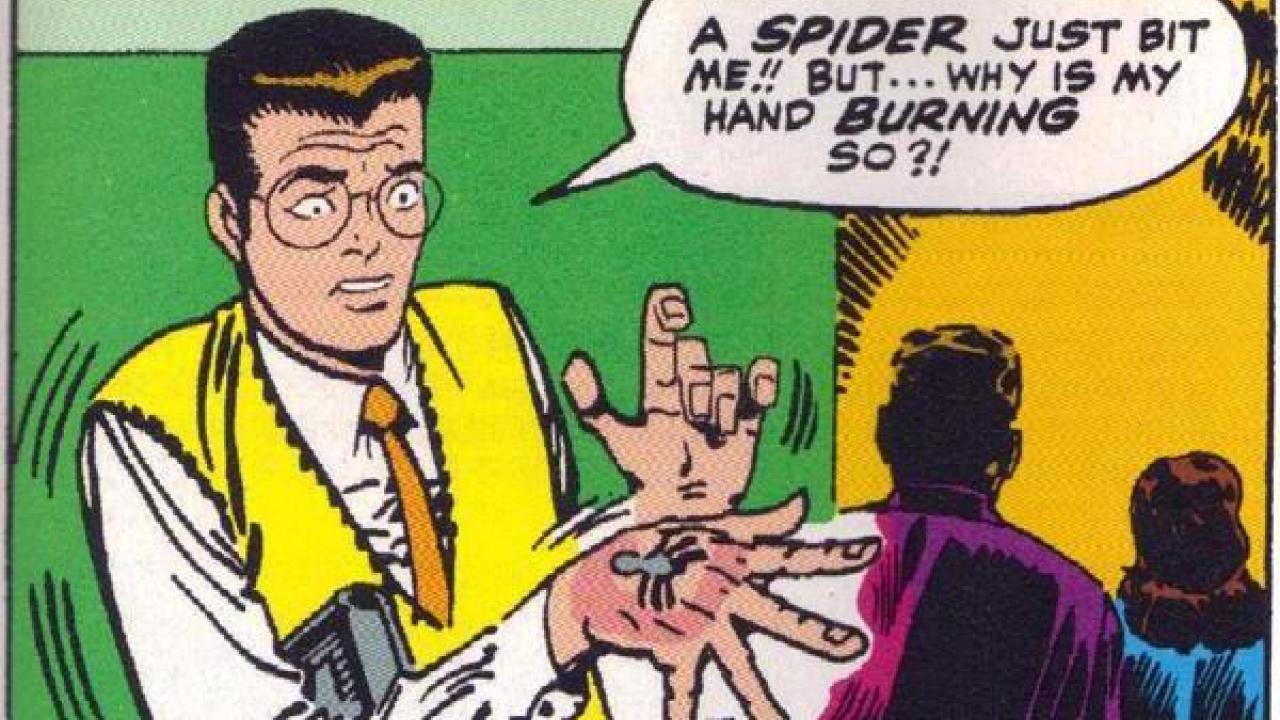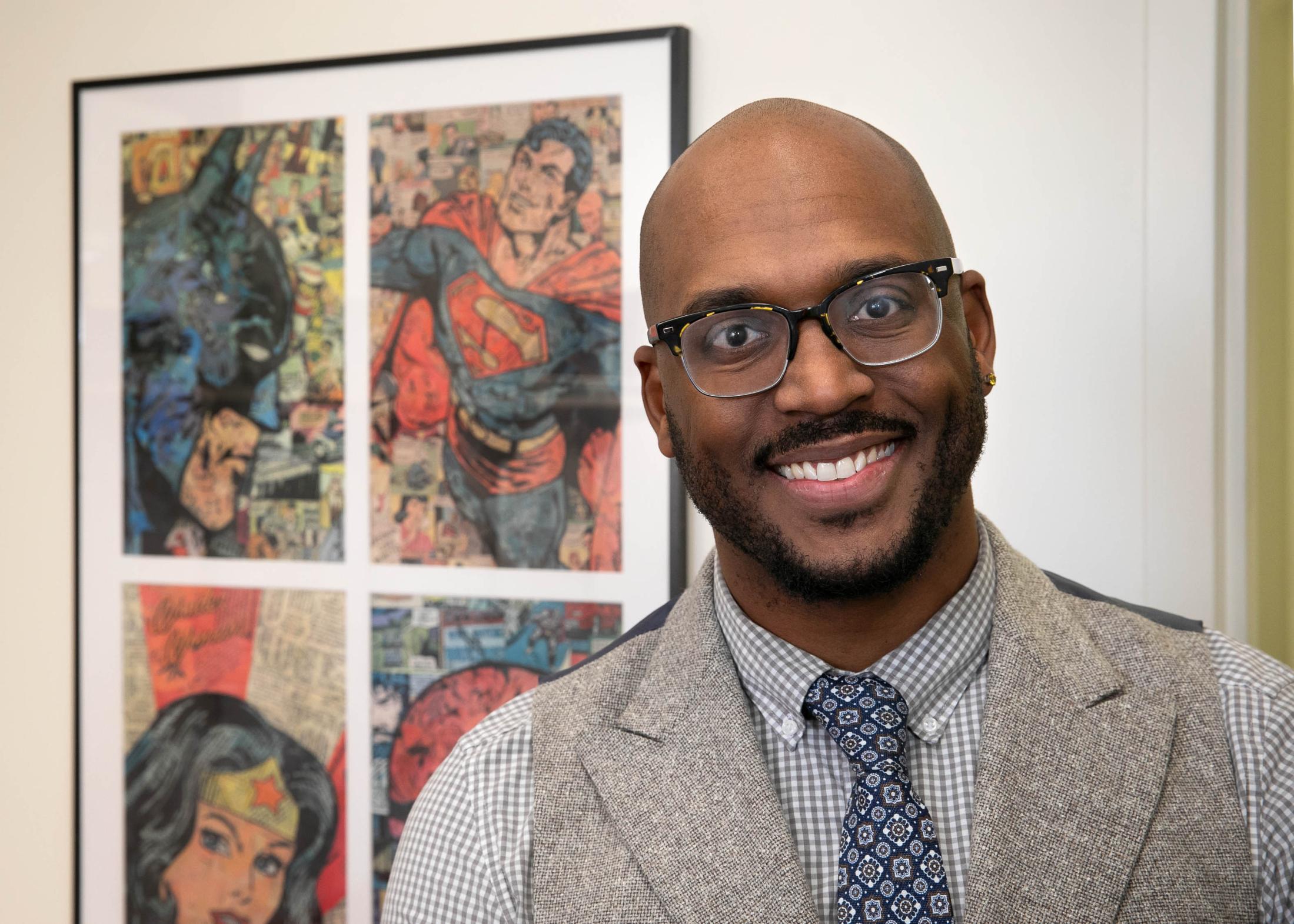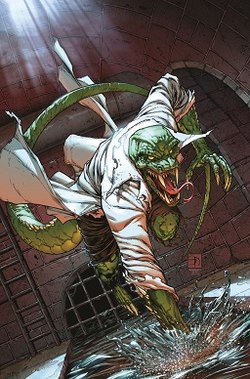
Your Friendly Neighborhood Science Communicator: Dr. Shane Campbell-Staton
“Spider-Man, Spider-Man, does whatever a spider can…”
Since the early 1960s, Spider-Man has had some technical upgrades — think the Iron Spider featured in the Tom Holland movies — but scientifically speaking, how does Spider-Man’s biology chalk up to spiders?

Dr. Shane Campbell-Staton was first inspired to connect the two worlds as a PhD student at Harvard University. While writing his dissertation, Dr. Campbell-Staton turned to comic books to “shut [his] brain down before going to sleep,” and the concepts of science and superheroes began to cross over. He first taught a short course on the subject as a grad student, and then worked it into an artistic outlet as a postdoc.
And thus The Biology of Superheroes podcast was born.
Now an assistant professor at University of California, Los Angeles, Dr. Campbell-Staton continues to balance academic life and science communication. Season 2 of The Biology of Superheroes started October 1, 2019, with a live recording about bio-inspiration and sustainability in Black Panther. I sat down with him to understand the origin of the podcast, and how he keeps it up. The interview has been edited for brevity and clarity.
Sydney Wyatt (SW): You’ve mentioned in the original promo and previous interviews that you picked up a comic book while writing your dissertation and that was the ah-ha moment for The Biology of Superheroes. How did that idea go from the class at Harvard to the podcast?
Shane Campbell-Staton (SCS): At Harvard they offer what are called J-term courses in the winter — short two-week courses taught by grad students. I did one on the biology of superheroes and there were six classes with six different topics connecting a comic book to a biology concept. The undergrads told me that the material was the same that they learned in their evolutionary biology courses, but more fun. As I started my postdoc I realized I wanted an artistic project that I could do in my free time. I thought about doing a blog for a long time, but I realized I don’t like writing that much. I will talk for a really long time so having conversations were more of a draw.
"The challenge I like most is explaining the fundamental interconnectedness of all things, like why this seemingly obscure thing relates to your everyday life."
I wanted to connect with people about science in casual setting, like going to a bar and bringing up Spider-Man with the person sitting next to me and having that conversation lead into biotechnology in a way that anyone can understand and relate to through the common ground of Spider-Man. In that sense, you’re not overestimating someone’s knowledge, but you’re not underestimating someone’s intelligence. I asked a friend from college, who was also a huge comic book nerd, if he wanted to do the first episode with me. We realized that it was really cool and gave us the opportunity to have conversations with scientists from across the country that we wouldn’t talk to otherwise because their research is outside of my field. It’s a chance for me to genuinely ask them questions in a colleague-to-colleague conversation, but also ask “what do you think about this superhero?” A lot of times [the guest] doesn’t know anything about them but we can still connect over the science behind the superhero.
SW: Since a lot of the scientists you reach out to are outside your field, how do you prepare for those conversations?
SCS: I never pretend to be an expert in their area, that’s what [the scientist is] there for, especially when the purpose of the conversation is not just about their research but making connections between a specific aspect of their work and an abstract concept like a superhero. I make sure to read their work in order to orient myself within the conversation. I’ve realized that diving into topics that I typically don’t think about, like math and physics for the Immortal Iron Fist episode, has made me a better scientist. In a sense, I’m reading material that I would never read otherwise.
On how episodes come together:
"Essentially every episode is a thought experiment. We consider science to be a quantitative thing, but there is some abstraction. Take Schrödinger’s cat: there’s no weird zombie cat, and it’s a strange way to think about quantum superposition. And there’s Stephen Jay Gould’s question, if you replay the tape of life, do you get the same result? I don’t know, I don’t have a time machine! It’s a great example of a thought experiment. In the same way, comic books offer interesting thought experiments on aspects of the living world in a sci-fi realm."
SW: Your podcasts have expanded from superheroes to Jurassic Park and even Star Trek. How do you pick your topic? Is it based on what’s popular at the time?
SCS: I’m not sure if I so much pick the topic or if it just pops into my head. My brain jumps a lot across subjects so I have an ongoing document of these ideas where I can write these thoughts down as they pop into my head. As of today, there are 56 episodes worth of ideas, just from these random connections. One example of this is the Incredible Hulk. He’s such a dope character that I want to do an episode on, but didn’t have a solid idea of where to start. Then it pops in my head some time later that maybe stress has something to do with the transition of Bruce [Banner] into the Hulk.

What if there’s a physiological mechanism in the Hulk’s universe that has to trigger the transformation? Can we use this character as a way of understanding the biology of stress? Why do we feel stressed? How do we feel stressed? What do our bodies do? That’s something most people don’t think about it. It’s like, “I’m stressed,” but why?
And then a few days later, I was hit by the idea of abnormal psychology. What is it like to have two completely separate entities that occupy the same brain? What is dissociative identity disorder? So, these ideas all go into that document.
SW: With the Incredible Hulk, stress and DID are two huge topics that are very different. How do you pick between the two?
SCS: They are two different things. I talked with two different people about these, too. I reached out to a stress physiologist and a psychiatrist to have conversations about these aspects. I’m going through the process now of re-listening to those conversations and pulling out soundbites that summarize major ideas. From there, it’s storytelling.
SW: What would you say is your go-to method for storytelling? My go-to is the through-line from The Official TED Guide to Public Speaking; I relate whatever I’m writing back to my main point. And there are other techniques too, depending on how you want to style your work.
"You’re not overestimating someone’s knowledge, but you’re not underestimating someone’s intelligence."
SCS: I think for me, I don’t have any rules about I put together a story because I think every story is different and has to be approached in different ways. I choose three major things that I want to get across. I also try to make personal connections to what the different themes are as well, whether it’s my connection to the hero or some aspect of my journey through science. You have to make it human. The challenge I like most is explaining the fundamental interconnectedness of all things, like why this seemingly obscure thing relates to your everyday life.
SW: How did you go about advertising the podcast? Your cohost has a career in marketing, so was that a part of the podcast taking off?
SCS: He certainly has taken the reins on that now. In the beginning, we just put it out there and the community played a huge role in our success that first season. Two grad students I worked with in my postdoc launched This Podcast Will Kill You and they got a shoutout from My Favorite Murder, which skyrocketed their podcast. So we did a sort of crossover episode with TPWKY about the biology of zombies — death and zombification in the natural world. And that brought in a lot of listeners. I was also featured in an episode of Ologies with Alie Ward’s podcast, which is regularly in the top 10 on the iTunes chart, which brought even more listeners. I remember this screenshot when we got like 4,000 downloads and we were like, "Oh my God 4,000 downloads!! This is the best!” So looking back we’ve picked up a lot of steam since then.
“If you want to do it, you’ll find time to do it. I like the idea of playing the guitar, like, that would be cool. Am I going to practice guitar for two hours a day? No, that means I don’t want to play the guitar. I just liked the idea of it.”
Now, a big part of it is maintaining consistency, which is something we weren’t good at in our first season. The hardest thing is to find the balance and I’ve come to realize that people have a tendency to find time for things they want to do. Some of it is logistical. I have to think strategically about when to interview people, when I have time to edit, and when my cohost and I are actually going to have time to sit down in the studio to record the episode. And then there’s including time for post-recording editing too. We can also generate more content through mini episodes where we look at updates in science and comic books as well as answer questions from fans. These are much easier to edit because they’re shorter and it’s just our conversation without extra soundbites to add in.
Thank you to Dr. Shane Campbell-Staton for sharing his insight on science communication through his podcast. Be sure to follow it wherever you get your podcasts and interact with them on Twitter and Facebook.
BONUS QUESTION!
SW: As a herpetologist, have you considered doing an episode on Lizard/Dr. Curt Conners or Killer Croc?
SCS: Curt Conners is a character I’ve been really interested in. His story is all about regeneration, with him being an amputee. He’s trying to reclaim his life by getting his arm back, and eventually does some messed up experiments that turn him into a monster.

This leads to an interesting exploration of regeneration, but so does the Wolverine. Some may argue that the Wolverine is a more interesting character for exploring a combination of regeneration and aging because those two things fit together. And we’re actually doing an episode on the Wolverine exploring those two things. In that conversation we’ll likely explore Curt Conners on the side.
Killer Croc is a different thing, mostly because he has multiple origins, some in which he’s a product of genetic engineering and some where he has epidermolytic ichtyosis. That origin is really interesting and gives an opportunity to look at macro mutation diseases that pop up in humans. The issue with some of this content is that you have to be aware of the cultural context in which the science exists. There’s a couple episodes that I’ve been sitting on for a long time because I haven’t found the right way to approach it because our podcast is pretty lighthearted. But we do deal with some heavy topics, like in the Hulk episode. But when you’re talking about genetically based diseases associated with abnormalities and deformations, you have to realize that there are people who are living their lives with these conditions. So equating that to Killer Croc needs a lot more forethought.
I recently ran into this with an upcoming Wonder Woman episode that we recorded live as part of a larger event. When I stepped on stage, I realized that everybody associated with the show was a dude and I had to take a second to acknowledge that: Yeah, I’m a dude, everyone up here has been dudes, but I’m about to explore the biology and physiology of Wonder Woman and the Island of the Amazons. It offers a really interesting thought experiment about the crazy things the female genome can do that the male genome can’t. But in the midst of the conversation if I say something that’s problematic, please speak up because this is an opportunity to have a conversation. And then we start the conversation about Wonder Woman.
Sydney Wyatt is a PhD student at the University of California in Davis. For more content from the UC Davis science communication group "Science Says", follow us on twitter @SciSays.

Comments